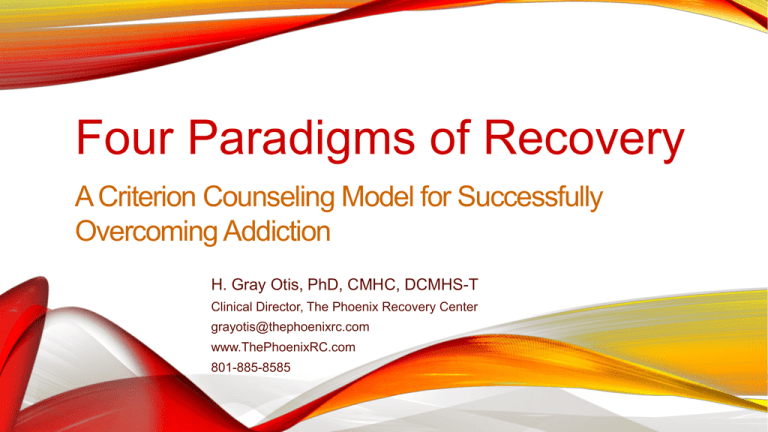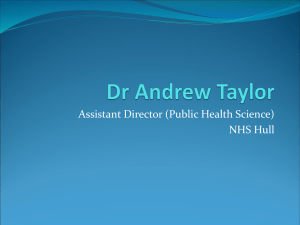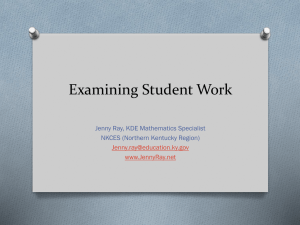
Four Paradigms of Recovery
A Criterion Counseling Model for Successfully
Overcoming Addiction
H. Gray Otis, PhD, CMHC, DCMHS-T
Clinical Director, The Phoenix Recovery Center
grayotis@thephoenixrc.com
www.ThePhoenixRC.com
801-885-8585
Professional Background
Clinical Director, Clinical Mental Health Specialist - Trauma
The Phoenix Recovery Center
Residential recovery treatment for men & women
The Phoenix Counseling Center
Intensive outpatient recovery treatment
General outpatient – adults, couples, families
Copyright H. Gray Otis, PhD, CMHC, 2013
Genesis
How do we assess successful recovery?
We know the criteria in order to diagnose substance dependence
Do we know what recovery is? What are the criteria?
What does “dual diagnosis” recovery mean?
Can we define behavioral health by the absence of symptoms?
Copyright H. Gray Otis, PhD, CMHC, 2013
Bias – Up Front Presumptions
My clinical concentration is on abstinence but there are other options
Focus of treatment
Addiction recovery
Trauma & chronic distress resolution
Health and strength development
Medications alleviate symptoms – but – do not resolve underlying causal
factors
Substance dependence is a biological disease with underlying
psychological origins – thus – dual diagnosis
Copyright H. Gray Otis, PhD, CMHC, 2013
Recovery Perspective
Treat the Addictions
•
•
Consider the symptoms of addictions – substance & behavioral
Could an addiction be symptomatic?
Treat the Underlying Causal Factors
•
•
Understand the unseen factors that created the addiction
These are often based in trauma or chronic distress
Encourage health & strength development
Copyright H. Gray Otis, PhD, CMHC, 2013
RESEARCH
What are the percentage of clients that as teens experimented with drugs or alcohol and
then got hooked?
Is this primary basis that explains why they became addicted?
Does the public believe that drug experimentation is the reason teens become addicted?
Copyright H. Gray Otis, PhD, CMHC, 2013
CURRENT RESEARCH
What are the percentage of clients that as teens experimented with drugs or alcohol and
then got hooked?
Is this primary basis that they became addicted?
Does the public believe that drug experimentation is the reason teens become addicted?
Current research addiction is based on:
1. Exposure
2. Vulnerability of the individual – genetic predisposition, past distress
3. Current situation of the individual – present distress
Copyright H. Gray Otis, PhD, CMHC, 2013
Factors of Psychological Health
Those who are generally healthy have:
1.
Positive Self-beliefs
2.
An Internal Sense of:
•
Emotional self-regulation
•
Nurturing self-care
3.
Effective Interpersonal Relationships
4.
Perspective of Purpose and Meaning
Copyright H. Gray Otis, PhD, CMHC, 2013
Four Paradigms of Recovery
Those in long-term recovery exhibit:
1.
Positive Self-beliefs
Believe
2.
An Internal Sense of:
Understand
•
Emotional self-regulation
•
Nurturing self-care
3.
Effective Interpersonal Relationships
Connect
4.
Perspective of Purpose and Meaning
Imagineer
Copyright H. Gray Otis, PhD, CMHC, 2013
Synopsis
Believe – Understand – Connect – Imagineer
The Four Paradigms of Recovery serve as a model to
integrate clients’ positive experiences which they had before their addiction with
current constructive recovery experiences.
This model correlates with Twelve Step principles.
Copyright H. Gray Otis, PhD, CMHC, 2013
Believe
Our Self-Beliefs Govern Life Choices & Outcomes
BELIEVE
“I am unworthy to be loved”
Virtually everyone in initial recovery does not accept that they are
worthy of being loved .
In many cases, this is the underlying reason for their dependence.
Copyright H. Gray Otis, PhD, CMHC, 2013
BELIEVE
“I am unworthy to be loved”
Virtually everyone in initial recovery does not accept that they are
worthy of being loved .
In many cases, this is the underlying reason for their dependence.
Substance or Behavioral Dependence
Shame Self-Beliefs
Copyright H. Gray Otis, PhD, CMHC, 2013
DEFINING SELF-BELIEFS
More than persistent personality traits
How the person experiences self - for example;
You alone see through your eyes and only you interpret what you perceive
No one will ever experience what you have – your unique combination of experiences
You daily construct your own unique world
This always links to what you believe about your self
Our self-beliefs essentially shape who we are
Copyright H. Gray Otis, PhD, CMHC, 2013
RESILIENCE RESEARCH
Individuals fall into one of two groups
Those individuals who deeply believe:
“I am unworthy to be loved”
‘I am not enough and never will be.’
‘I am ashamed of myself’
‘I cannot stand who I am so I numb myself with food, addictions, ‘right’ thinking, meds, anger,
etc.
How does this correlate with those who suffer from substance addiction?
Copyright H. Gray Otis, PhD, CMHC, 2013
Other Shame Self-Beliefs
I don’t deserve love
I am a bad
I am worthless
I deserve bad things
I am damaged, broken
I am ugly
I am stupid, not smart enough
I don’t matter
I don’t belong, I am different
I am irresponsible
I cannot be trusted, trust myself
I cannot trust others
I am weak, not in control
I am a failure
I am imperfect, flawed, I must please
Copyright H. Gray Otis, PhD, CMHC, 2013
UNDERSTANDING SHAME
• Shame self-beliefs distort and disfigure how individuals perceive themselves.
• Evidence is accumulated that the shame beliefs are true
• The psychic pain of shame dominates consciously and subconsciously
e.g. destructively disparaging self-talk
Shame is the petri dish in which the bacteria of addiction thrive
Copyright H. Gray Otis, PhD, CMHC, 2013
SHAME SELF-BELIEF QUALITIES
Distinguishing between guilt and shame
Guilt:
“I did something wrong or bad,” “I did something dumb,” “I acted carelessly,” etc.
Guilt motivates us to change
Copyright H. Gray Otis, PhD, CMHC, 2013
SHAME SELF-BELIEF QUALITIES
Distinguishing between guilt and shame
Guilt:
“I did something wrong or bad,” “I did something dumb,” “I acted carelessly,” etc.
Guilt motivates us to change
Shame:
“There is something wrong with me – I am bad,” “I am dumb,” “I am careless,” etc.
Shame beliefs lead us to accept the lie that we cannot change
Copyright H. Gray Otis, PhD, CMHC, 2013
SHAME SELF-BELIEF QUALITIES
Distinguishing between guilt and shame
Guilt:
“I did something wrong or bad,” “I did something dumb,” “I acted carelessly,” etc.
Guilt motivates us to change
Shame:
“There is something wrong with me – I am bad,” “I am dumb,” “I am careless,” etc.
Shame beliefs lead us to accept the lie that we cannot change
Counselors must be skilled in shame resolution
Copyright H. Gray Otis, PhD, CMHC, 2013
THE SELF-BELIEF CONTINUUM
Fear/Shame
1
Love/Empathy
2
3
4
5
6
On a scale from 1 to 7, how much of the individual’s life is
lived with love and empathy?
Low scores correlates with shame self-beliefs & addictions
Copyright H. Gray Otis, PhD, CMHC, 2013
7
ORIGINS OF SHAME SELF-BELIEF
Shame self-belief arises from emotionally charged events (trauma) as well as other
disturbing experiences (small t trauma, chronic distress, developmental trauma)
The individual lives with distress such as a loss of attachment, fear for the safety of self or
others, chronic low-grade anxieties, cultural conflicts, feelings of inadequacy, etc.
There is often a sense of terrible helplessness
These deep seated emotions may be manifested in almost any DSM disorder and all
substance dependence disorders
In order to blunt the high level of fear & shame, individuals use coping mechanisms that
provide instant, temporary relief – most commonly substance or behavioral addictions
Copyright H. Gray Otis, PhD, CMHC, 2013
SHAME SELF-BELIEF RESULTS
Shame self-belief induces negative coping mechanisms
In addition to drugs and alcohol, individuals may turn to sex, gambling, working, religion,
blaming, exercise, politics, eating disorders, or any other addiction patterned behaviors
Shame Self-Beliefs most often lie in the subconscious
Self-beliefs trump everything else mentally & emotionally – they color are decision making
We must go beyond cognitive-behavioral therapy
’Counselors can create the pre-conditions for transforming Shame Self-Beliefs
into Positive Self-Beliefs
Copyright H. Gray Otis, PhD, CMHC, 2013
POSITIVE SELF-BELIEFS
The second of the two groups :
Those individuals who predominantly believe:
“I am worthy to be loved”
How many individuals with addictions have this self-belief?
What can we learn from this?
Copyright H. Gray Otis, PhD, CMHC, 2013
THE TRANSFORMATIONAL APPROACH
Counselors need an evidenced-based model to understand the underlying
basis of mental disorders including substance dependence:
“Client shame self-beliefs relate to attachment, abandonment, and trauma”
Shame Self-beliefs can be transformed into Positive Self-beliefs
Outcome research shows that addressing underlying shame is a critical
aspect dependence recovery.
Copyright H. Gray Otis, PhD, CMHC, 2013
TRANSFORMATIONAL SELF-BELIEFS
Shame self-belief example:
‘I am evil’ replaced with:
What are the chances for his recovery?
Copyright H. Gray Otis, PhD, CMHC, 2013
“I am acceptable!”
“I am evil”
TRANSFORMATIONAL APPROACH
Show clients how to transform ‘Shame Self-Beliefs’
1.
Develop Client Emotional Regulation
2.
Treat Trauma
3.
Promote Positive Self-Beliefs
4.
Support Forgiveness, No Use of Labels, Self-Change, Addiction Recovery
Which comes first?
Copyright H. Gray Otis, PhD, CMHC, 2013
THERAPEUTIC CONSIDERATIONS
Seek out shame beliefs:
“What are
you ashamed of?”
“What traumatic
or chronic distress experiences have you had?” (e.g. abuse,
accidents, injuries, combat, learning difficulties, bullying, alcoholic caregiver, etc.)
“What negative
beliefs do you have about yourself starting with the words; ‘I am. . .’?
(e.g. “I am unsafe,” “I’m stupid,” “I am out of control,” I’m a terrible parent,” etc.)
Distinguish for the client the difference between guilt and shame
Help clients transform shame self-beliefs into positive self-beliefs – Brene Brown
(TED Talk - Vulnerability, etc.)
Copyright H. Gray Otis, PhD, CMHC, 2013
TREAT TRAUMA & CHRONIC DISTRESS
Trauma & attachment are at the center of shame self-belief - understand GAD, PTSD, small
t trauma, mTBI, developmental trauma
Know how to help client’s effectively process trauma – evidenced based options
Body work
EMDR
Sand tray, play therapy
Thought Field Therapy, Acupressure Tapping, (Instant Emotional Healing, Lambrou & Pratt),
Affirmations
Cognitive Processing Therapy
Trauma Focused CBT
Stress Inoculation Therapy
Others?
Copyright H. Gray Otis, PhD, CMHC, 2013
Ethical responsibility to effectively treat or to refer
EFFECTIVE TREATMENT
Results – positive self-beliefs become dominant
1. Individuals convert shame self-beliefs to positive self-beliefs and they know it
2. Triggers are no longer experienced
3. The shame experiences are integrated in memory
4. The results are permanent
The impact of life-threatening industrial accident on Nate
Chronic distress or trauma is more difficult for many clients to resolve – Belinda’s story
Copyright H. Gray Otis, PhD, CMHC, 2013
STRENGTHENING SELF
Practiced 12-15 times a day for 7 weeks
Positive Self-Belief elements:
1. Strong positive emotional memory visualization
2. Body memory sensation
3. Belief: “I am worthy to be loved!”
4. Finger to thumb connection
Demonstrated by the counselor – five iterations
Client logging method
Client preparation: “The toughest experiment you will ever do”
Client reports back at the next session
Copyright H. Gray Otis, PhD, CMHC, 2013
OUTCOMES OF POSITIVE BELIEF
Alleviation of root source of substance dependence
Enhanced emotional resilience
Better physical well-being
Improved relationships
Increased appreciation, enjoyment, & meaning
Lasting recovery outcomes
Copyright H. Gray Otis, PhD, CMHC, 2013
Understand
• Emotional self-regulation
• Nurturing self-care
EMOTIONAL SELF-REGULATION
Virtually all people afflicted with dependence have used substances
and behaviors to numb out painful emotions
Withdrawal usually brings an immense increased of often overwhelming
emotions and feelings
Most do not have a vocabulary to describe what they are experiencing
They feel flooded with unwanted emotional pain
“We are swimming in a sea of our own emotions”
Copyright H. Gray Otis, PhD, CMHC, 2013
THERAPEUTIC CONSIDERATIONS
Teach an easy-to-understand emotional vocabulary
Distinguish between secondary emotions (e.g. “I am mad”) from primary
feelings (e.g. I feel Accused, Guilty, Rejected, Unlovable, and/or Powerless)
so that the client can identify and discuss their emotions and feelings
Focus on their emotional experience (e.g. What emotions are you
experiencing now. What are your feelings?)
Copyright H. Gray Otis, PhD, CMHC, 2013
DEVELOP EMOTIONAL REGULATION
Help clients understand their emotions and feelings:
Fear/Shame
1
2
3
4
5
I am Mad – Sad - Anxious
I feel:
• Accused
• Guilty
• Rejected
• Unlovable
• Powerless
“When I am out of WAC – I feel AGRUP”
“However, I can regulate how I feel”
Copyright H. Gray Otis, PhD, CMHC, 2013
Love/Empathy
6
7
I am Glad
I feel:
• Worthy
• Acceptable
• Capable
THERAPEUTIC CONSIDERATIONS
Help them learn principles of emotional intelligence particularly how to
regulate their emotions.
Clients rarely know how to perceive the balance that is needed for recovery?
They seldom recognize how the 12 Steps integrate the key elements of
successful living.
Help them daily review their well-being.
Copyright H. Gray Otis, PhD, CMHC, 2013
Understand
• Emotional self-regulation
• Nurturing self-care
NURTURING SELF-CARE
Clients hardly ever know how to perceive the balance needed for recovery
They seldom recognize how the 12 Steps integrate the key elements of
successful living
Help them daily review their well-being.
Copyright H. Gray Otis, PhD, CMHC, 2013
THERAPEUTIC CONSIDERATIONS
A new approach to a greeting
Instead of; “Hi, how are you?”
Copyright H. Gray Otis, PhD, CMHC, 2013
THERAPEUTIC CONSIDERATIONS
A new approach to a greeting
Instead of; “Hi, how are you?”
How goes your H E A R T?
How is your
How are your
How is your
How are your
How is your
Health?
Emotions?
Awareness?
Relationships?
Transcendent spirituality
Copyright H. Gray Otis, PhD, CMHC, 2013
HEALTH
How is your Health?
Sleep 7 to 8 hours
Eat well
Drink enough water
Exercise regularly *
Take care of health needs
Nurture your well-being
Stop smoking *
Take a supplement if needed
Limit caffeine, sodas, & sugar
Which of these lower the risk for relapse?
Which of these are you modeling for your clients?
Copyright H. Gray Otis, PhD, CMHC, 2013
EMOTIONS
How are your Emotions?
Recognize emotions & feelings
Practice appreciating
Regulate & soothe yourself
Understand yourself
Appreciate positive feelings
Use empathy to understand others
Emotional mindfulness is prerequisite to emotional intelligence
We cannot control emotions but we can regulate them & soothe ourselves
Copyright H. Gray Otis, PhD, CMHC, 2013
AWARENESS
How is your Awareness?
Know what you are focusing on
Value the worth of others & self
Use your mind to resolve shame
Realize that you are becoming more
Work through guilt
Worthy, Acceptable, and Capable
Cognitive awareness is central to reason, logic, and effective action
The ability to focus our mind changes our brain
Copyright H. Gray Otis, PhD, CMHC, 2013
RELATIONSHIPS
How are your Relationships?
Clean up your side of the street
(& only your side)
Support the “Five Positives to One
Negative Interactions”
Work through resentments
Sit as an adult not as a parent or child
Practice forgiveness
Know your family constellations
Almost every person with an addiction as been the ‘victim’ of others
Continuing to blame is almost a sure sign of relapse – How come?
Copyright H. Gray Otis, PhD, CMHC, 2013
TRANSCENDENT SPIRITUALITY
How is your Transcendent Spirituality?
Develop your own sense of the
spiritual
Find the joy in enjoyment and the
heart of courage in encouragement
Tap into the energy of your higher
Become open to ‘Coincidences’
power
How many of your clients have ‘religion problems’
Many have not understood their spiritual experiences
(e.g. nature, caring, connection, wonder, etc.)
Copyright H. Gray Otis, PhD, CMHC, 2013
SELF-CARE
The Self-care Imperative for Recovery
Recovery is not a simplistic formula
However, there are factors that greatly decrease risk factors
Most clients do not understand these concepts on first hearing
Seeking a balance in
health, emotions, awareness, relationships, and spirituality
is an ongoing, life-long journey
Copyright H. Gray Otis, PhD, CMHC, 2013
Factoids
Additional Job Security
What is the new pain med that will hit the streets next month?
Copyright H. Gray Otis, PhD, CMHC, 2013
Additional Job Security
What is the new pain med that will hit the streets next month?
FDA approved in record time
FDA advisory panel voted 11 to 2 against approval
Alleviates chronic pain
Better than Hydrocodone
Copyright H. Gray Otis, PhD, CMHC, 2013
5 – 10 mg
Additional Job Security
What is the new pain med that will hit the streets next month?
FDA approved in record time
FDA advisory panel voted 11 to 2 against approval
Alleviates chronic pain
Better than Hydrocodone
Here comes Zohydro ER
Copyright H. Gray Otis, PhD, CMHC, 2013
5 – 10 mg
50 mg
LIMITATIONS
“Because of the risks of addiction, abuse, and misuse with opioids,
even at recommended doses, and because of the greater risks of
overdose and death with extended-release opioid formulations, reserve
Zohydro ER for use in patients for whom alternative treatment options
are ineffective, not tolerated, or would be otherwise inadequate”
Copyright H. Gray Otis, PhD, CMHC, 2013
COUNTER POINT
We need effective pain medications
Physicians must assess for risks
1. Exposure
2. Vulnerability of the individual
3. Current situation of the individual
There usually are options for those at risk of dependency
Copyright H. Gray Otis, PhD, CMHC, 2013
Factoids
Considerations
Best predictor of successful therapy outcomes?
Copyright H. Gray Otis, PhD, CMHC, 2013
Considerations
Best predictor of successful therapy outcomes?
Counselors who ask their clients how they can be
more effective.
Copyright H. Gray Otis, PhD, CMHC, 2013
Connect
Isolation is the common thread in substance or
behavioral addictions
PROBLEMATIC RELATIONSHIPS
They have poor relational conceptualizations
Expectations are high & acceptance is low
There is little ‘friendship’ in their relationships
Copyright H. Gray Otis, PhD, CMHC, 2013
THE POWER OF FRIENDSHIP
When individuals rediscover how to be friends:
Relationships start to heal & then flourish
The pieces fit
How does this happen?
Copyright H. Gray Otis, PhD, CMHC, 2013
THERAPEUTIC CONSIDERATIONS
Every friendship is composed of two separate relationships.
For example;
I have a relationship with Mark, my colleague at work
But Mark has a different perspective about his relationship with me
Copyright H. Gray Otis, PhD, CMHC, 2013
RECALL A CLOSE FRIEND
Examples, a grandparent, a favorite friend growing up, a current BFF,
anyone you felt very close to (but not your spouse)
Think about how well you related to this friend
Then estimate how well they related to you
There are five qualities of interactions which summarize the closeness &
the effectiveness of the relationship between any two people. They are:
Copyright H. Gray Otis, PhD, CMHC, 2013
G R E A T FRIENDSHIPS
Ask: Am I really . . .
•
Genuine? Do I demonstrate that I am genuine by being honest, sincere, open, truth full, & transparent so
that others can be at ease with me?
•
Respectful? Do I respect the ability of every adult to make their own choices even when I disagree? Do I
allow them to be responsible for the results of their decisions?
•
Empathetic? Do I express through empathy that I care enough to listen, understand, and want the best for
the other person? Do I understand what others are saying, their feelings, their fears & their caring love?
•
Accepting? Do I fully accept the other person as they are. Even when I disagree with them, can I express
my thoughts without ‘constructive criticism’ or imposing my values and expectations on them?
•
Trustful? Do I believe in the basic good-hearted nature of the other person by acknowledging the best
about them? Am I trustful of their intentions?
Copyright H. Gray Otis, PhD, CMHC, 2013
AM I GENUINE?
Do I demonstrate that I am genuine by being honest, sincere, open, truth
full, & transparent so that others can be at ease with me?
‘Are you honest, truthful, and open with your friend?’
‘Is it easy to be sincerely yourself?’
‘How do you encourage your friend to be comfortable with you?’
‘Does this work for both you and your friend?’
Copyright H. Gray Otis, PhD, CMHC, 2013
AM I RESPECTFUL?
Do I respect the ability of every adult to make their own choices even when I
disagree? Do I allow them to be responsible for the results of their decisions?
‘Do you consent that your friend has the right to make their own decisions, even
when you differ with them?’
‘Does your friend allow you to do the same?’
‘Does this work for both of you?’
Copyright H. Gray Otis, PhD, CMHC, 2013
AM I EMPATHETIC?
Do I express through empathy that I care enough to listen, understand, and want
the best for the other person? Do I understand what they are saying, their
feelings, their fears & their caring love?
‘Do you really try to understand your friend?’
‘Is it important for you to work ‘as a team’ and to be concerned about each
other’s best interests?’
‘Do both of you strive to understand the others perspectives and feelings?’
Copyright H. Gray Otis, PhD, CMHC, 2013
AM I ACCEPTING?
Do I fully accept the other person as they are. Even when I disagree
with them, can I express my thoughts without ‘constructive criticism’ or
imposing my values and expectations on them?
‘Do you accept your friend, the good and not so good?’
‘Do you almost always refrain from criticizing them?’
‘Do you refrain from requiring your friend to meet your expectations?’
‘Are both you and your friend accepting of each other without feeling
submissive or compliant?’
Copyright H. Gray Otis, PhD, CMHC, 2013
AM I TRUSTFUL?
Do I believe in the basic good-hearted nature of the other person by
acknowledging the best about them? Am I trustful of their intentions?
‘Do you consistently see your friend as ‘well-intentioned?’
‘Generally, do you assume the best about your friend?’
‘Are you both trustful that each of you are good-hearted?’
Copyright H. Gray Otis, PhD, CMHC, 2013
G R E A T FRIENDSHIPS
If you are almost always . . .
Genuine
Respectful
Empathetic
Accepting
Trustful
Your relationship with your friend might look something like the
following slide:
Copyright H. Gray Otis, PhD, CMHC, 2013
MEASURING G R E A T:
10 _
9 _
10 _
9 _
10 _
9 _
10 _
9 _
10 _
9 _
8 _
7 _
8 _
7 _
8 _
7 _
8 _
7 _
8 _
7 _
6 _
5 _
6 _
5 _
6 _
5 _
6 _
5 _
6 _
5 _
4 _
3 _
4 _
3 _
4 _
3 _
4 _
3 _
4 _
3 _
2 _
1 _
2 _
1 _
2 _
1 _
2 _
1 _
2 _
1 _
0
GENUINE RESPECTFUL EMPATHETIC ACCEPTING TRUSTFUL
Copyright H. Gray Otis, PhD, CMHC, 2013
G R E A T FRIENDSHIPS
If your friend is almost always . . .
Genuine
Respectful
Empathetic
Accepting
Trustful
You can estimate that your friend’s relationship with you might look
like the following slide:
Copyright H. Gray Otis, PhD, CMHC, 2013
G R E A T RELATIONSHIPS
10 _ _
9 _ _
10 _ _
9 _ _
10 _ _
9 _ _
10 _ _
9 _ _
10 _ _
9 _ _
8 _ _
7 _ _
8 _ _
7 _ _
8 _ _
7 _ _
8 _ _
7 _ _
8 _ _
7 _ _
6 _ _
5 _ _
6 _ _
5 _ _
6 _ _
5 _ _
6 _ _
5 _ _
6 _ _
5 _ _
4 _ _
3 _ _
4 _ _
3 _ _
4 _ _
3 _ _
4 _ _
3 _ _
4 _ _
3 _ _
2 _ _
1 _ _
2 _ _
1 _ _
2 _ _
1 _ _
2 _ _
1 _ _
2 _ _
1 _ _
0
GENUINE RESPECTFUL EMPATHETIC ACCEPTING TRUSTFUL
Copyright H. Gray Otis, PhD, CMHC, 2013
G R E A T RELATIONSHIPS
10 _ _
9 _ _
10 _ _
9 _ _
10 _ _
9 _ _
10 _ _
9 _ _
10 _ _
9 _ _
8 _ _
7 _ _
8 _ _
7 _ _
8 _ _
7 _ _
8 _ _
7 _ _
8 _ _
7 _ _
6 _ _
5 _ _
6 _ _
5 _ _
6 _ _
5 _ _
6 _ _
5 _ _
6 _ _
5 _ _
4 _ _
3 _ _
4 _ _
3 _ _
4 _ _
3 _ _
4 _ _
3 _ _
4 _ _
3 _ _
2 _ _
1 _ _
2 _ _
1 _ _
2 _ _
1 _ _
2 _ _
1 _ _
2 _ _
1 _ _
0
GENUINE RESPECTFUL EMPATHETIC ACCEPTING TRUSTFUL
How would you assess your relationships (e.g. family, clients, etc)?
Copyright H. Gray Otis, PhD, CMHC, 2013
CREATING ‘G R E A T’
Focus on ‘what works’ and ‘what doesn’t work’
Ask yourself to do more of ‘what works’
Do G R E A T experiments
Observe how you feel, think, & act
Observe the results
Report how it works
As we model a G R E A T friendships we grow in our abilities
Copyright H. Gray Otis, PhD, CMHC, 2013
G R E A T FRIENDS
Empathetic
Empathetic
Respectful
Accepting
Respectful
YOUR
FRIEND
YOU
Genuine
Copyright H. Gray Otis, PhD, CMHC, 2013
Accepting
Trustful
Genuine
Trustful
THE POWER OF FORGIVENESS
Resolving the imbedded resentment of trauma & chronic distress
Forgiving is not:
Forgetting
Excusing
Trusting
Continuing relationship
Copyright H. Gray Otis, PhD, CMHC, 2013
THE POWER OF FORGIVENESS
Resolving the imbedded resentment of trauma & chronic distress
Forgiving is not:
Forgetting
Excusing
Trusting
Continuing relationship
Forgiving lets go of the need for another to suffer for my sake
Resolved resentment alleviates triggers & frees the forgiver
Copyright H. Gray Otis, PhD, CMHC, 2013
BUILD GREAT CONNECTIONS
Overcoming addiction’s isolation
Work through passed relationships concerns
Family conflicts
Prior injurious relationships
The impact of the addiction on loved ones
Build functional, fun relationships – 12 steps, friends, etc.
Learn how to trust & rely on others
Develop a “Cone of Support” – Self, Reliable Others, H P
Copyright H. Gray Otis, PhD, CMHC, 2013
THE POWER OF CONNECTION
We all want to be heard, understood, and accepted
When we practice hearing, understanding, & accepting
others – we become more
Worthy
Acceptable
Capable
Copyright H. Gray Otis, PhD, CMHC, 2013
Factoids
Considerations
Testosterone levels decrease with opioid use
Copyright H. Gray Otis, PhD, CMHC, 2013
Considerations
Testosterone levels decrease with opioid use
Consider testosterone hormone replacement therapy after
three months of abstinence & not feeling normal
Copyright H. Gray Otis, PhD, CMHC, 2013
Considerations
Testosterone levels decrease with opioid use
Consider testosterone hormone replacement therapy after
three months of abstinence & not feeling normal
ADD, ADHD can interfere with recovery
Copyright H. Gray Otis, PhD, CMHC, 2013
Considerations
Testosterone levels decrease with opioid use
Consider testosterone hormone replacement therapy after
three months of abstinence & not feeling normal
ADD, ADHD can interfere with recovery
Consider Strattera (non-stimulant) medication
Copyright H. Gray Otis, PhD, CMHC, 2013
Imagineer
Helping those recovering to visualize and create
meaningful, enjoyable lives
THE CRUCIAL QUESTION
“What are you going to do with the rest of your life?”
In addiction, creativity is focused on obtaining, using, & hiding the use
of substances
There is little or no effort concentrating on obtaining enjoyment,
meaning, or fulfillment
Those caught up in dependence fear the responsibility & opportunity
to create their own life
In recovery, sobriety is never enough – it is fundamental but each
person has to envision their life as satisfying & worthwhile
Copyright H. Gray Otis, PhD, CMHC, 2013
WALT DISNEY’S DILEMMA:
Many of his staff were talented artists – he valued their creative
imaginations
But in developing Disneyland, he needed engineers to turn
imagination into reality
How could he combine the best of both?
Today’s most coveted work title for Disney employees
Copyright H. Gray Otis, PhD, CMHC, 2013
WALT DISNEY’S DILEMMA:
Many of his staff were talented artists – he valued their creative
imaginations
But in developing Disneyland, he needed engineers to turn
imagination into reality
How could he combine the best of both?
Today’s most coveted work title for Disney employees
Imagineer
Copyright H. Gray Otis, PhD, CMHC, 2013
THERAPEUTIC CONSIDERATIONS
Engage the client in identifying their values:
Many do not know their values
Many are conflicted between their held values & behaviors
Listing values by each person in a group is value provoking
Individuals can track their own reliability
Self-trust is dependent upon consistency at 97%
Copyright H. Gray Otis, PhD, CMHC, 2013
WHAT R U 4?
Identify aspirations (We are what we desire to be)
Show how unproductive it is to focus on what they do not want
Help them focus on the desires they want in their life
Teach them to use the power of visualization
Demonstrate how to daily engineer the creation of their desires
Create a wheel of good fortune
Copyright H. Gray Otis, PhD, CMHC, 2013
Factoids
Consider
If an individual smokes within one hour of wakening there
is a significantly greater risk of addiction
What does this mean for those who are in recovery?
Copyright H. Gray Otis, PhD, CMHC, 2013
Bringing it Home
THE FOUR PARADIGMS OF RECOVERY:
1.
Integrate withTwelve Steps programs
2.
Address the underlying distress sources of addictions
3.
Help clients build their life’s path & their own program of recovery
4.
Are based on holistic health principles utilizing individual skill development
5.
Positive reinforcement is a natural effect of using these skills
6.
Clients learn how to put into practice these skills & achieve better outcomes
7.
It is imperative that we also attend to taking care of ourselves by practicing these
skills with our clients, those whom we work with, as well as our family and friends
Copyright H. Gray Otis, PhD, CMHC, 2013
Four Paradigms of Recovery
Those in long-term recovery meet the following criteria:
1.
Believe
They exhibit positive self-beliefs
2.
Understand
They show an internal sense of
Emotional self-regulation
Nurturing self-care
1.
Connect
They achieve effective interpersonal relationships
2.
Imagineer
They realize their own purpose and meaning
Copyright H. Gray Otis, PhD, CMHC, 2013
Questions?
Four Paradigms of Recovery
A Criterion Counseling Model for Successfully
Overcoming Addiction
H. Gray Otis, PhD, CMHC, DCMHS-T
Clinical Director, The Phoenix Recovery Center
grayotis@thephoenixrc.com
www.ThePhoenixRC.com
801-885-8585







